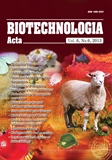ISSN 2410-776X (Online),
ISSN 2410-7751 (Print)

"Biotechnologia Acta" v. 6, no 6, 2013
https://doi.org/10.15407/biotech6.06.086
Р. 86-93, Bibliography 14, Russian.
Universal Decimal classification: 577.114.7:57.083.36
CYTOTOXIC AND DNA-DAMAGE ACTIVITY OF THE PREBIOTIC SUBSTANCES
L. A. Safronova1, S. I. Voychuk1, B. G. Suhov2, V. S. Pidgorskiy1
1Zabolotny Institute of Microbiology and Virology of National Academy of Sciences of Ukraine, Kyiv
2Favorskiy Institute of Chemistry of Siberian Department of Russian
Due to the widespread of the ecological disorders and diseases of the gastrointestinal tract of humans and animals there is an increased interest in probiotic products (probiotics, prebiotics and synbiotic), which showed its efficacy and safety in their treatment and prevention. Yeast Saccharomyces cerevisiae and cell culture of a human larynx cancer НЕр-2 were used to study cyto- and DNA-damage effects of several polysaccharides (arabinogalactan and nanobiocomposite of arabinogalactan with flavonoids, karraginan, galactomannan and their hydrolyzed derivatives), which are new perspective prebiotic substances. Cytotoxic potential of substances was determined from MTT-assay and DNA-damage effects were determined by morphological and structural features of cell nuclei. The synergic action of the polysaccharides with chemical triggers of cellular damages (hydrogen peroxide, acetic acid, nitrosomethylurea) was evaluated. The studied substances possessed no cyto- and DNA-damage action on the yeast and mammalian cells. It was shown that polysaccharides were able to enhance the effects of hydrogen peroxide, acetic acid and nitrosomethylurea. Nature of the marked effects remains unclear, but it may be assumed that the studied prebiotic substances can be used to enhance the effects of some chemical compounds and appear promising for use in integrated biomedical preparations of varied spectrum.
Key words: arabinogalactan, karraginan, galactomannan, Saccharomyces cerevisiae, human larynx cancer НЕр-2 cells, cytotoxicity, DNAdamage effects.
© Palladin Institute of Biochemistry of National Academy of Sciences of Ukraine, 2013
References
1. Bondarenko V. M., Grachova N. M., Matsulevich T. V., Vorobiov A. A. Microecological changes in the intestine and their correction by means of therapeutic and prophylactic drugs. Zh. gastroenterol. gepatol. Koloproktol.. 2003, 4 (20), 66–76. (In Russian).
2. Aleksandrova V. A. Fundamentals of the immune system of the gastrointestinal tract: Method. allowance. SPb: MAPO. 2006, 44 p. (In Russian).
3. Guarner F., Khan A. G., Garisch J. Probiotics and prebotics. World Gastroenterol. Organisation Pract. Guideline. 2008. http://www.worldgastroenterology.org/ assets/downloads/en/pdf/guidelines/19_probiotics_prebiotics.pdf.
4. Roberfroid M., Gibson G. R., Hoyles L. Prebiotic effects: metabolic and health benefits. Br. J. Nutr. 2010, 104 (2), 1–63.
https://doi.org/10.1017/S0007114510003363
5. Andersson Y., Asp N.-G., Bruce A. Health effects of probiotic and prebiotics. A literature reviev on human stadies. Scand. J. Nutr. 2001, V. 45, P. 58–75.
6. Guidance on Genotoxicity Testing and Data Interpretation for Pharmaceuticals Intended for Human Use. Federal Register, 7 June 2012. 77 (110), 33748–33749.
7. Carmichael J., DeGraff W. G., Gazdar A. F. Evaluation of a tetrazolium-based semiautomated colorimetrie assay: assessment of chemosensitivity testing. Cancer Res. 1989, V. 47, Р. 936–942.
8. Kregiel D., Berlowska J. Evaluation of yeast cell vitality using different fluorescent dyes. Sсi. Bul. Tech. Un. Food Chem. Biotechnol. 2009, 73 (1058), 5–14.
9. Karathia H., Vilaprinyo E., Sorribas A., Alves R. Saccharomyces cerevisiae as a model organism: a comparative study. PLoS ONE. 2011, 6 (2), e16015.
https://doi.org/10.1371/ journal.pone.0016015.
10. Zimmermann F. K. Testing of chemicals for genetic activity with Saccharomyces cerevisiae: a report of the U.S. Environmental Protection Agency Gene-Tox Program. Mutat. Res. 1984, 133 (3), 199–244.
11. Chen T. R. Re-evaluation of HeLa, HeLa S3, and HEp-2 karyotypes. Cytogenet. Cell Genet. 1988, N 48, Р. 19–24.
12. Stephanou G., Vlastos D., Vlachodimitropoulos D., Demopoulos N. A. A comparative study on the effect of MNU on human lymphocyte cultures in vitro evaluated by O6-mdG formation, micronuclei and sister chromatid exchanges induction. Cancer Lett. 1996, 109 (1–2), 109–114.
https://doi.org/10.1016/S0304-3835(96)04432-1
13. Weyermann J., Lochmann D., Zimmer А. A practical note on the use of cytotoxicity assays. Intern. J. Pharmaceut. 2005, V. 288, Р. 369–376.
14. Krysko D. V., Vanden Berghe T., D’Herde K., Vandenabeele P. Apoptosis and necrosis: detection, discrimination and phagocytosis. Methods. 2008, 44 (3), 205–221.
https://doi.org/10.1016/j.ymeth.2007.12.001

